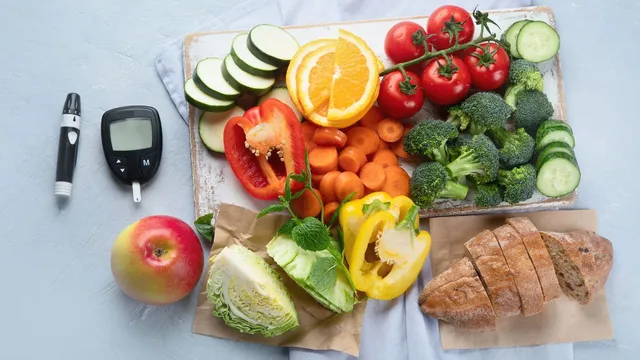- By Prerna Targhotra
- Fri, 15 Nov 2024 04:51 PM (IST)
- Source:JND
Diet For Diabetes: What you consume reflects on your blood sugar reading within 2 hours, which allows for very personalised fine-tuning of the diet, to ensure that you are staying on track with your health goals, and diabetes management. For a person with diabetes, a healthy diet is rich in non-starchy vegetables, lean proteins, complex carbohydrates and healthy fats.
In a conversation with Jagan English, Safia Livingston, Dietician (MS RD) at MASSH (Minimal Access Smart Surgery Hospital) explained that the Mediterranean diet is endorsed by the American Heart Association (AHA) and American Diabetes Association (ADA) and this diet has been seen to improve insulin sensitivity, reduce HbA1c and regulate blood sugar. However, the Mediterranean diet is not always a viable option due to availability, taste preference and cost.
The 3 basic building blocks to a healthy diet, when managing blood sugar, that you can incorporate with any cuisine are portions, the pairing of foods and protein. To manage portion sizes, without having to measure and weigh food, follow a healthful plate method.
Half of your plate should be filled with non-starchy vegetables – broccoli, cauliflower, leafy greens etc. These vegetables can be in the form of a salad, steamed, stir-fried or sabji, though use minimal oil if the vegetables are being cooked.
A quarter of your plate should be filled with complex carbohydrates that have a higher glycaemic index, thus not spiking your blood sugar. Some options include whole wheat rotis, brown rice, millet, oats etc.
-1731668552863.jpg)
Diet For Diabetes Management (Image Credits: Canva)
A quarter of your plate should be filled with a lean protein source, such as chicken, fish and eggs; for vegetarians choose paneer, tofu, lentils, sprouts and beans. We often consider lentils and beans such as dal, rajma and channa as protein, they contain protein, but they also contain carbohydrates. Thus, when eating lentils and beans, reduce the amount of rice or roti you consume.
Additionally, a bowl or katori of raita or curd on the side, to boost gut health. Choose to drink water, instead of juices or sugar-sweetened beverages. Choose fruit as a dessert, rather than having a sweet dish.
The pairing or combination of foods impacts your blood sugar. Choosing protein or fibre-rich foods to consume with carbohydrate-rich foods will increase the glycaemic index, reducing the impact on your blood sugar, as well as keeping you satiated for longer. Simple additions such as adding ground seeds to rice or as a snack choosing nuts and seeds to eat with fruit, cut vegetables and yoghurt dip or papad and tomato salad.
Use the acronym – ‘SUGAR’ to balance blood sugars:
Spices – add blood sugar-lowering cinnamon, fenugreek and turmeric.
Understand Meal timings – small meals at regular times 3 hours apart.
Get Moving! Blood sugar is better controlled with exercise, as it naturally takes sugar from the blood and pushes it into the cells to utilise while exercising.
Add protein to meals & snacks.
Roughage & fibre increases the glycaemic index of foods.
ALSO READ: Do Diabetes And Hypertension Increase Risk Of Strokes? Doctor Explains
ALSO READ: Can Diabetes Be Prevented? Doctor Lists Measures To Prevent This Looming Health Crisis

